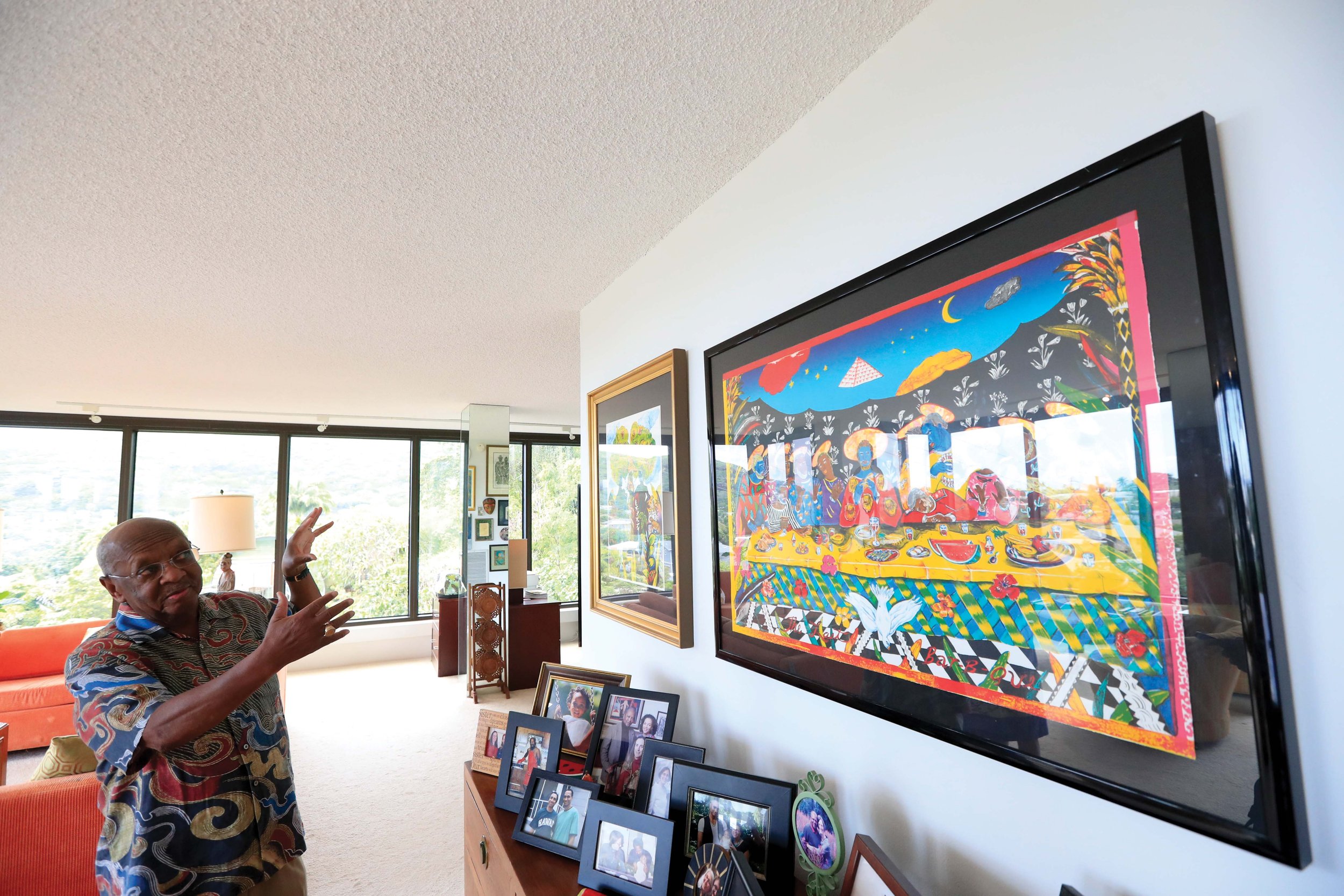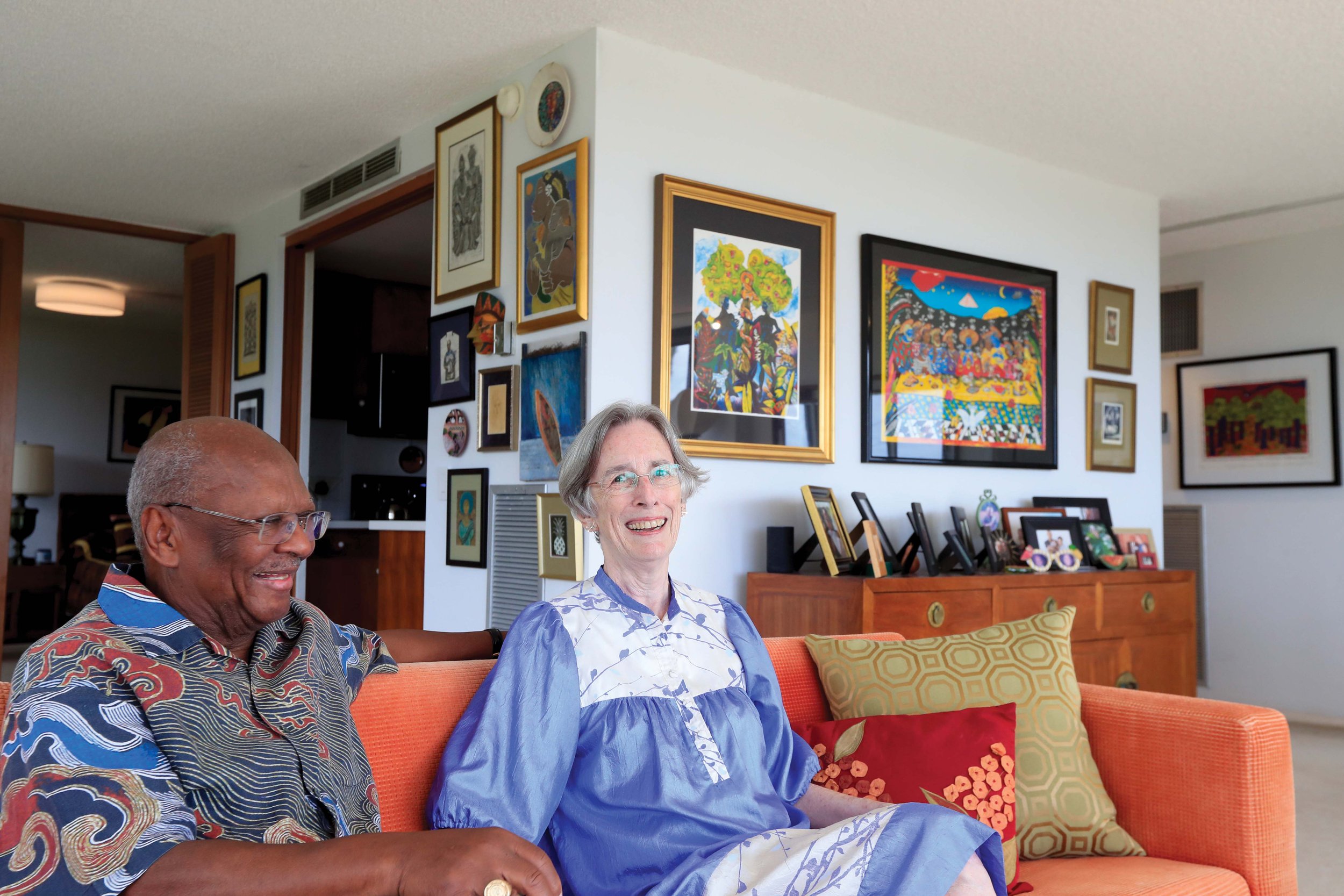Down to a Fine Art








Of the hundreds of works of art that Jean and Robert Steele have collected over the past five decades, one particular piece holds a special significance for the couple: Three African Women in Profile, which artist Tony Northern painted in pastel on the side of a cardboard box.
In 1968, while interning as a hospital chaplain in New York City, Robert Steele discovered the painting one afternoon on a visit to the Harlem Art Gallery during his break. He was immediately enamored, marveling at the complexity of the colors and imagining what the women in the painting might be discussing, or mourning, or meditating on.
When Steele inquired about the price of the painting and learned it was $25 ($226 in 2024 dollars), he gave pause. Robert and his wife Jean were both graduate students — they had met a year prior while attending Episcopal Theological School in Cambridge, Massachusetts — and were living on a limited income. “In those days, $25 could buy a lot of groceries,” Robert Steele says. “After a little discussion, Jean told me to go for it.”
When Robert Steele returned to the gallery to buy the painting the following day, a different artist who was working quoted Steele a new price: $12.50. “Sold,” says Steele, who used the leftover funds to buy another piece, a pencil drawing of Malcolm X.
These purchases ignited a flame in Steele and would lead to many others for the couple. Over time, Jean and Robert decided to focus their collection specifically on works on paper, such as drawings, lithographs, serigraphs, linocuts, and other types of prints, by African American artists. “We have sometimes bought pieces because they were created by a certain artist or it would be good for the collection,” Steele says. “Generally, I buy a piece if that image is captivating; if the artwork speaks to me somehow.”
Robert Steele didn’t know much about art growing up in Prichard, Alabama, a small town north of Mobile. His father worked as a janitor and part-time candymaker. His mom sometimes cleaned houses while taking care of Steele, his four brothers, and one sister. “My parents were committed to their kids getting an education. My siblings and I all have at least master’s degrees,” says Steele.
Steele attended Atlanta’s Morehouse College in the early 1960s as an English major and sociology minor. There he made two important friends. The first was Reverend Warren Scott, the Episcopal chaplain at the Atlanta University Center, who became a mentor for Steele.
Wanting to follow in his role model’s footsteps, Steele pursued theology with the goal of becoming a pastoral counselor. This brought him to New York City, where Steele interned at Harlem and Bellevue Hospitals, ultimately earning his PhD in Psychology instead of becoming a chaplain. (“The doctorate only took four years. Becoming a certified chaplain would have taken five,” he explains.)
Steele’s second friend was his roommate, Edmund Barry Gaither, who also majored in English as well as art history. When Steele took breaks from his student job at Atlanta University’s Trevor Arnett Library, he often wandered into the library’s gallery to view the art; Gaither later educated Steele on the artists whose works were on display. (Gaither would go on to serve as the founding director of the National Center of Afro-American Artists in Boston.)
“Barry would say, ‘Bob, you were looking at all the major [Atlanta University Annual] art prize winners!’” Steele says. “These were pieces by African American artists like Romare Bearden, Jacob Lawrence, Faith Ringgold, David Driskell, Sam Gilliam...” Many names whose works Jean and Robert Steele would wind up collecting over the years.
Like Romare Bearden, who, in 1977, created 20 collages that reimagined scenes from Homer’s epic poem The Odyssey. As a young child, Bearden moved with his family to Harlem as part of the Great Migration of African Americans from the rural (and inhospitable) South to greater opportunity in the urban North from roughly the 1910s to the ’70s.
The lives of travelers going to and from home was a significant theme for Bearden throughout his career; six prints from Bearden’s Black Odyssey series can be found in the Steeles’ bedroom, along with the couple’s first-ever art purchase by Northern. (Jean and Robert have an eye for vivid colors and imagery that reflects Black history, social justice, and spirituality.)
The Steeles’ Hawai‘i Kai condo is a trove of works. Not necessarily just the best of the best from their extensive collection, but also pieces that have personal meaning. There are pencil drawings of the Reverend Scott and Barry Gaither, plus a lithograph print by dynamic cubist Jacob Lawrence entitled Carpenters (1977) that depicts cabinetmakers working diligently, an homage to the art of construction and creation.
Overlooking the Steele’s dining room is Margo Humphrey’s The Last Bar-B-Que (1987), a playful take on Leonardo da Vinci’s Last Supper with all African Americans and Southern food on the table. Humphrey was a colleague of Steele’s at the University of Maryland College Park, where Steele was a psychology professor and associate dean of the College of Behavioral and Social Sciences for 40 years.
After he retired from teaching, Steele served as the executive director of the university’s David C. Driskell Center for nearly a decade, helping to promote art by African Americans and the African diaspora. Esteemed artist and art historian David Driskell created a colorful collage in honor of Steele’s 65th birthday, which has also found a place in his home. The Steeles moved to O‘ahu in 2016, where their daughter lived and where Jean’s family originally emigrated from Portugal in 1852.
“After all these years, I got to know the artists we collected, knew the art world, and had fun. Now we’re in the process of deaccessioning and finding homes for our collection,” says Steele, who has donated art to Morehouse College, Williams College, and numerous other institutions. He and Jean have given more than 100 works of art to Yale University, where Steele earned his PhD (and has since established several scholarships to support students of color).
Most recently, the couple has given a partial gift of 55 prints to the Honolulu Museum of Art, which more than doubles the number of African American artists represented in the museum’s permanent collection. A recent exhibition of these works, Forward Together: African American Prints from the Jean and Robert Steele Collection, closed at HoMA this past September. It’s the latest exhibition featuring works from the Steeles’ collection, but certainly not their last.
“We still have a lot to give and a lot to accomplish,” says Steele. “We’re not done yet.”
